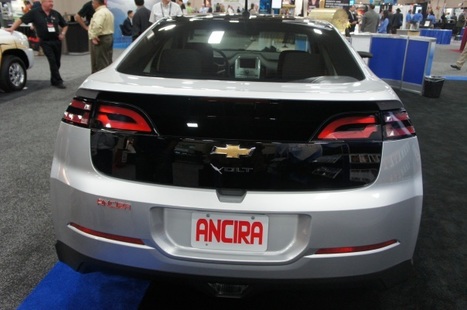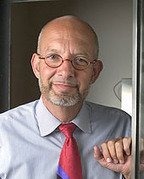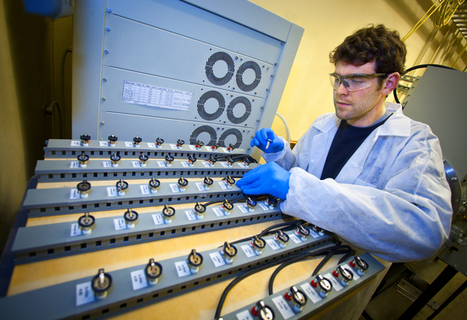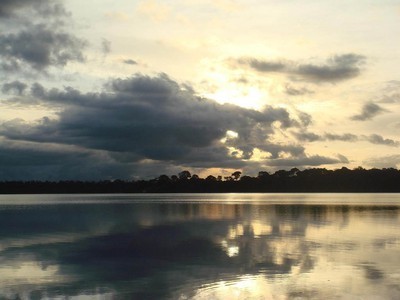 Your new post is loading...
 Your new post is loading...
Despite the work the U.S. has done the past decade to make information technology ubiquitous, a digital divide persists between America and some of the fast-advancing European countries. Interestingly, while the country’s large land area is still one of the main factors impeding the U.S. government’s ability to successfully leverage its IT capabilities to a maximum, the biggest reason for the country’s underperformance has been its “less than satisfactory” political and regulatory environment, according to The Global Information Technology Report 2012 [PDF]. That opinion was echoed by Beñat Bilbao-Osorio, associate director and senior economist at the World Economic Forum and one of the report’s authors. Although the U.S. is excelling on many technology fronts from a global perspective, Bilbao-Osorio said the American government still hasn’t been able to make the best use of IT and technology infrastructure. Click headline to read more and access hot link to the report--
It’s an easy and cheap way to support renewable energy in Minnesota! Buying green power doesn’t mean that your home is individually powered by wind power, but it does mean that your utility will purchase that much more energy from a turbine rather than a coal burning plant. You can show your utility that you think renewable energy is an important resource and help reduce your carbon footprint. Click headline to read more--
When thinking about cleantech, I tend to think in terms of resources and supply constraints, meaning that when we switch from a fossil fuel like coal to a renewable resource like wind, I consider what natural resources we’re newly dependent on (unfortunately it’s more than just wind). The move to renewable energy has a lot of great advantages—reduced particulate matter from not burning hydrocarbons, more stable energy prices, energy security, and yes, slowing the accumulation of greenhouse gases driving climate change. But this week I’d like to take a look at five natural resources that will significantly impact the future development of renewable energy. Click headline to read more--
Sustainability is now firmly on the agenda in the Middle East and North Africa (MENA); with the development of Masdar at the hub of a low carbon future, we are continually seeing a shift away from fossil fuels towards a variety of clean energy and power solutions. Some of the most surprising movements are happening in oil-rich countries such as Saudi Arabia and Qatar. Here, I offer a look at the rise in alternative energy projects in the Middle East and the large numbers of renewable energy job opportunities being created. Currently, the MENA region meets 98 percent of its energy requirements through oil and gas, having benefited from abundant hydrocarbon resources and low costs in the region. However, rising oil prices combined with a greater understanding by the Middle East of the impacts of global warming and growing energy demands, brought about by huge infrastructure development, have resulted in depleting reserves and a clear need to diversify. Fortunately, the geography and climate conditions of the MENA region are highly conducive to the development of renewable energy sources, most notably solar and wind. Clik headline to read more--
Proponents of net metering report sending 60,000 emails to the California Public Utilities Commission (CPUC) urging it to increase the amount of solar photovoltaic (PV) generation which can participate in the state's policy, by challenging current utility practice in calculating the state net metering cap. The CPUC has indicated in a preliminary ruling that utilities are using an overly restrictive approach to calculating this cap, and on May 24th, 2012 the agency will vote on this proposal. The Vote Solar Initiative warns that under current policy, the cap could be reached as early as mid-2013. "When we crafted California’s original net metering law, the goal was maximize the amount of clean distributed energy on the grid," said former Assemblyman Fred Keeley, author of California’s net metering law. "By proposing this methodology, the CPUC is complying with the original legislative intent and helping California lead the way toward a clean energy economy." Click headline to read more--
IntelliGen Power, a leader in distributed power projects, is announcing today their availability to provide free assistance to businesses and municipalities seeking funding through the New Jersey Clean Energy Solutions Large Scale CHP (LSCHP) Program. “This program is a great opportunity for businesses to get free money to pay for their CHP systems,” said David Lesser, President of IntelliGen Power. “The utility rates in New Jersey already make cogeneration a very appealing solution for energy users looking to save money, and support from this program drives down the cost even more. Even without this funding, cogeneration projects in New Jersey typically pay for themselves in less than 5 years.” Click headline to read more--
"The Morning Briefing" is SmartPlanet's daily roundup of must-reads from the web. This morning we're reading about LED technology and innovative use. Click headline to access hot links to articles--
Can the startup accelerator model work for battery companies? The folks behind CalCharge, the brainchild of Lawrence Berkeley National Lab and California Clean Energy Fund (CalCEF) that hopes to attract some 30 battery companies in the San Francisco Bay Area, think so. Through CalCharge, battery tech developers will be able to enlist the help of researchers and use equipment at Berkeley Lab and other research institutions, participate in seminars and forums, recruit engineers and other employees and network with each other to trade information. Companies can do all this on their own, of course, but they might find better results when they go through an organization that pools resources to serve a larger community. “What I’ve been hearing for a while is that in the Silicon Valley and the software industry, there is an ecosystem to bring everybody together,” said Venkat Srinivasan, head of energy storage and distributed resources department at Berkeley Lab. “We recognize that battery companies want an ecosystem to work together.” Click headline to read more--
|
Last summer I wrote about a study of the greenhouse gas impact of large hydropower dams, how it's lower than often assumed but still varies widely based on where the dams are built. Now there's some more research on how when hydropower dams are built in the tropics, the emissions are much, much higher than their counterparts in temperate regions—so much so that they really can't be considered a clean energy source, a solution to climate change. Mongabay reports on a study in Nature Climate Change, which has determined that "various mathematical errors have resulted in Brazil's electrical authorities estimating the magnitude of emissions from reservoir surfaces at a level of only one-fourth what it should be. [...] The myth can no longer be sustained that tropical dams produce clean energy." Click headline to read more--
A Scottish smart grid strategy has been announced to develop technologies which match electricity supply with demand. The blueprint announced by First Minister Alex Salmond at a conference in Aberdeen is accompanied by a target to create 12,000 new jobs by 2020. It is claimed that Scotland already has world-class research in smart grids and related technologies. The strategy was developed by a working group of academics and individuals from industry and academics. Smart grids help match energy demand to changeable supply, from wind for example. On behalf of the group, Prof Jim McDonald, the principal of the University of Strathclyde, said: "The Smart Grid Sector Strategy represents an important step forward in capturing Scotland's industry opportunities in one of the largest power engineering infrastructure developments in the 21st Century. Click headline to read more--
On June 6 we will conduct an information session in Traverse City, MI for residential electric customers interested in learning about customer-installed solar energy systems. This free session will be held at the Aero Park campus of Northwestern Michigan College from 5:30 to 8:30 p.m. and is open to the public. Speakers during the session will provide information on how customers can install their own solar energy systems as part of Consumers Energy’s Experimental Advanced Renewable Program (EARP). Reservations for this session and information about the program are available at www.consumersenergy.com/EARP. Click headline to read more and access hot links
Before Facebook's recent initial public offering, the media obsessed over superlatives. It was the largest-ever IPO for a U.S. technology company. It was the third-largest in U.S. history. And now the obsession is over the company's lackluster revenue prospects and possible misconduct by investment bankers involved in the offering. Missing here is any awareness of the enormous quantities of electricity Facebook and other data-intensive technology companies require. Those requirements expose a fundamental mismatch between the high-power-density world of Big Data and the low-density electricity production inherent in most renewable energy projects. Click headline to read more--
On May 18, Vermont’s Governor Shumlin signed into law the 2012 Energy Bill, which contains a groundbreaking acknowledgement of the locational benefits of distributed generation and more than doubles the amount of clean local energy that will be brought online through the state’s CLEAN Program. The new law expands Vermont’s statewide CLEAN Program, known locally as the Standard Offer program, from 50 megawatts (MW) to 127.5 MW. Notably, the capacity of any distributed generation facility that provides “sufficient benefits to the operation and management of the electric grid” as a result of its location or other characteristics will not count towards the overall program cap of 127.5 MW. Therefore, no limit exists on the amount of clean local energy that can come online from facilities providing sufficient locational benefits. The recognition of locational benefits by Vermont legislators is a major step towards broader awareness of the true value of distributed generation. Clean local energy projects alleviate transmission and distribution (T&D) constraints, while also avoiding the inefficient and expensive long-distance transmission of energy. Click headline to read more--
The Canadian government is taking another step towards aligning Canadian vehicle standards with those of the U.S. Denis Lebel, Canadian Minister of Transport, Infrastructure and Communities, announced yesterday that the Government of Canada is continuing its commitment to advance clean vehicle technologies with the launch of the second phase of the ecoTECHNOLOGY progam. The Clean Transportation Initiatives focus on aligning Canadian regulations with those in the United States and with international standards, improving the efficiency of the transportation system and advancing clean technologies. The second phase of the ecoTECHNOLOGY for Vehicles Program was launched by Minister Lebel. In the words of Minister Lebel: “this program will assess the safety and environmental performance of new vehicle technologies to ensure that innovations can be introduced in Canada in a safe and timely manner.” Click headline to read more--
TXU Energy introduced on Wednesday a new product that will alert customers during the course of the month if their electricity bill is headed over budget. The emailed budget alerts warn customers when their electricity usage hits a point that is likely to result in a bill that is higher than a particular spending threshold. Customers can set their own bill thresholds, and TXU doesn't charge its customers for the service. The idea is that the customer gets a warning in time to slow down household electricity usage before the billing cycle ends. Click headline to read more--
|



 Your new post is loading...
Your new post is loading...













![Renewable energy can't run the cloud [or much else] | The Hockey Schtick | @The Convergence of ICT, the Environment, Climate Change, EV and HEV Transportation & Distributed Renewable Energy | Scoop.it](https://img.scoop.it/V0xX8Iqrx1qzwv9YLmZjXjl72eJkfbmt4t8yenImKBVvK0kTmF0xjctABnaLJIm9)






